Sapphire Toxic HD4870 1GB DDR5
Jan 6th, 2009 | By Simon
Sapphire Toxic HD4870 1GB DDR5
Date
: 01/6/09 – 04:13:08 AM
Author
:
Category
: Video Cards
Page 1 : Index
Manufacturer
: Sapphire Tech
It was only a few short weeks ago when I got to took the Sapphire Toxic HD 4850 out for a spin. There was no doubt in my mind that it was a great card – it offered great performance at a very good price. In these harsh economic times, value is king. Sapphire just introduced the
Toxic HD 4870 1GB
and I hear it packs a mighty punch on the street.

I've got the pleasure of putting this card up against several other Sapphire bad boys, including the Toxic 4850 and HD4850X2. New with this card is the Vapor-X: Vapor Chamber Technology. An efficient cooling solution that uses three heatpipes to vent heat away from the card without increasing noise.
Page 2 : Package & Contents
Christmas came early for me as Sapphire shipped the Toxic HD4870 to me overnight so it would arrive on the 24th of December. The packaging is almost identical to the Toxic HD4850. The large silver man makes up the background with the company name and product taking the front stage. Along the perimeter of the box are some included features when you purchase the card. On the back we have some more product highlights, included technology and past awards won.
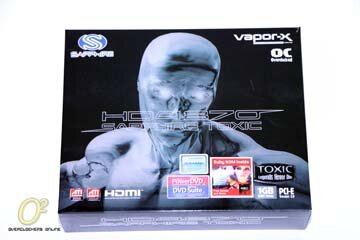
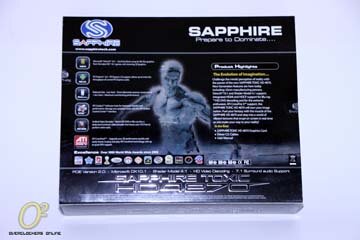
On one of the open sides, we have the product label providing the product number, SKU and various other serial numbers. With the other side, we have an extensive breakdown of the system requirements and available external connections.
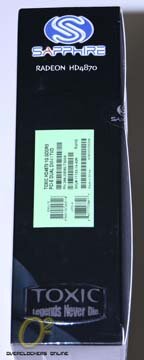
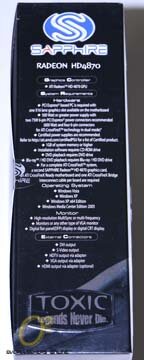
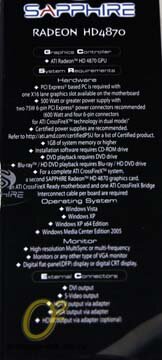
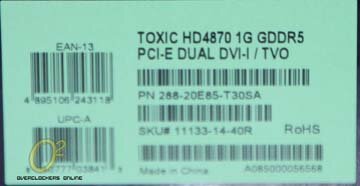
The last two sides of the box simply state HD4870 Sapphire Toxic.

After opening up the retail package, you need to open up a second brown box to get at the card. We can immediately see that Sapphire takes protection to a whole new level. The card is wrapped in a thick padded anti-static bag and further enclosed in a three-quarter inch thick sound dampening type foam. Beneath the foam is where all the drivers and external connectors are hidden: one Sapphire manual, 5 CDs/DVDs, two power adapters, one DVI-VGA dongle, one DVI-HDMI dongle, one CrossFire link, one set of HD TV-out and one S-Video to Video out adapter.
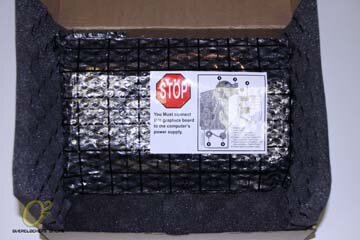
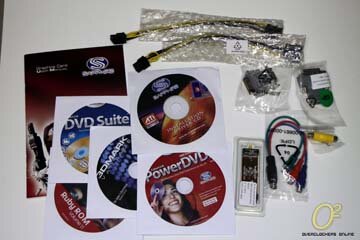
Here's our first look at the card:
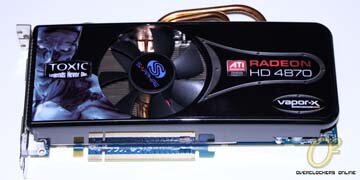
The shroud immediately reminded me of the HD4850X2 but with the inclusion of the Vapor-X technology, I know I'm going to be in for a thermal treat!
Page 3 : Specifications & Vapor-X
Sapphire's Toxic 4870 1GB is in many ways similar to the 512MB version that was released a few months ago. Let's head over to their website and check out the details of the Toxic HD 4870 1GB.
Product Spec
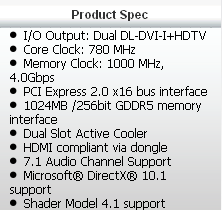
Features
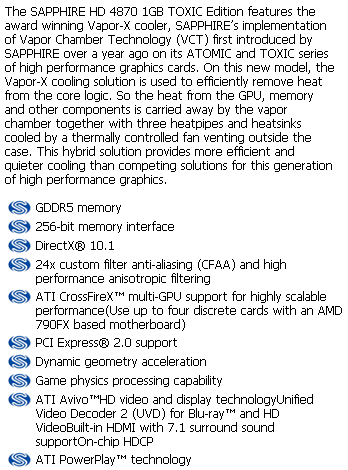
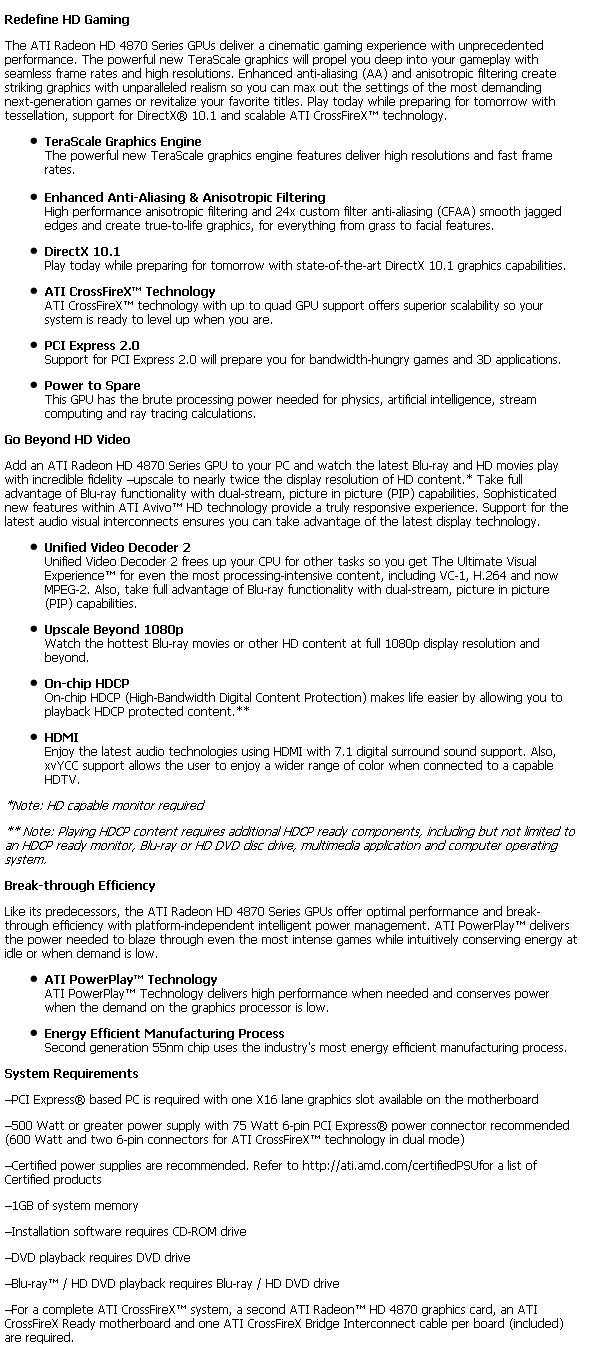
Before we go any further, I just want to highlight a little on Sapphire's Vapor-X technology. The technology is similar in principle to how a heatpipe works. Liquid is vaporized at the hot end and condensed at the cold end. The liquid is re-circulated back down to the hot end via a wick system. What's new with the Vapor-X technology is that they have been able to flatten the process into a slim chamber.
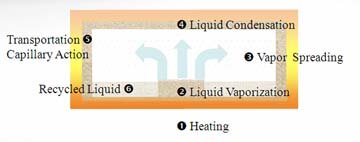
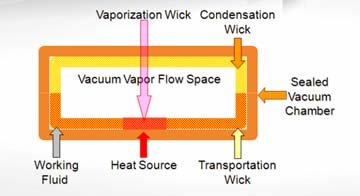
From the picture below, you can see that the hot zone is the GPU and the Vapor-X technology will transfer the heat to the cooler zones of the card where airflow from the fan will dissipate it from the card.
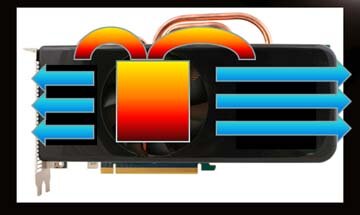
Sapphire had, and I quote, a test done in 25C room temperature running ATi Tool 0.27 for one hour and noticed the built by ATI card had a temperature of 74.5C whereas the Sapphire Toxic was only 58.5C. I won't be comparing the effectiveness of the cooler as I don't have a reference cooler but I will share with you my thermal test results.
Page 4 : Product Walk Through
It didn't take very long for me to rip open the package left by UPS so I could get at the card. Let's have a closer look at the card:
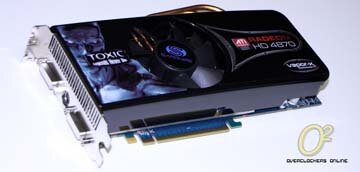
The card uses three heatpipes in the Vapor-X cooling system and these are visible on onside of the card. The side that slides towards your motherboard is completely bare.


While the card uses Vapor-X technology which claims to be a slim profile, it still remains a double slot card. Facing the card we see the two DVI outputs and video out port. At the back end of the card we see the two 6 pin auxiliary power connectors – both are required in order for the card to fully function.
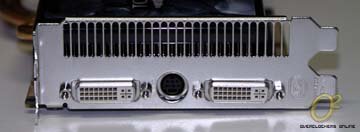
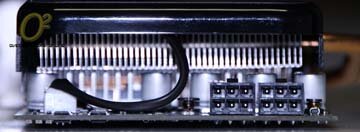
Flipping the card over is pretty uninteresting for all you will find are a few stickers with serial numbers on them and the eight screws required to hold the cooler down. Pulling the cooler off we see a copper insert where the GPU sits, this would be the hot zone for the Vapor-X and thermal tape for the memory chips. There is a single sleeved power cable that runs from the fan to the PCB.
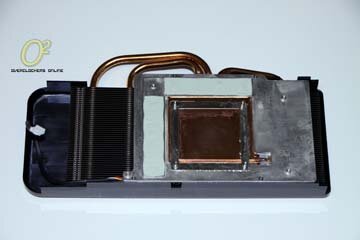
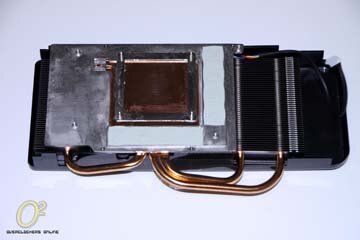
Page 5 : Product Walk Through Continued
Removing another 4 screws on the underside of the heatsink allows you to lift the plastic shroud off. I was disappointed that Sapphire decided to use a plastic shroud over an aluminum one. The aluminum would have been heavier but it would provide better natural heat dissipation.
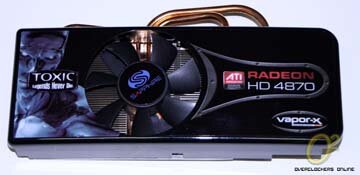
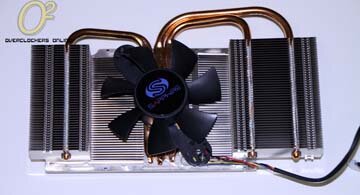
With everything taken apart, we can get a very close up look at the assembly of the heatsink. I counted 47 fins wide, all of which seem to fit onto a common foot that is inserted into the base of the heatsink.
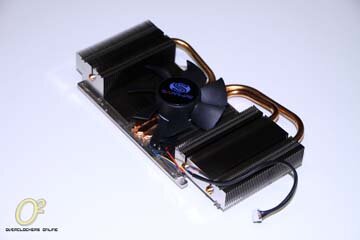
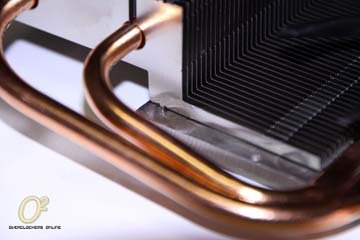
Having stripped the card naked, with the exception of the PWM, I'm able to get a clean look at the components making up the video card.
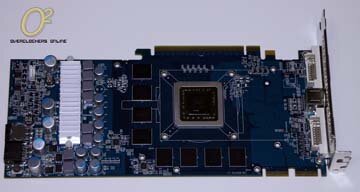
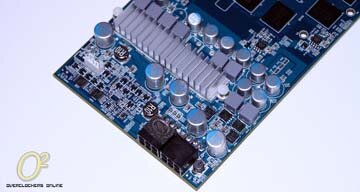
The core was manufactured in week 34 of 2008. It has the serial number NK2151.00 215-0669049. The memory is supplied by Qimonda. It was manufactured in week 40 of 2008. It has the serial number IDG V16-05A1F1C-40X HVV43054. The datasheet is available here. The modules are rated for DDR5-1000 at 1.5V. Since this card comes factory clocked at 780/1000 which is above the 750/900 stock, I don't expect to be getting too much more out of the card. However, that doesn't mean we won't try!
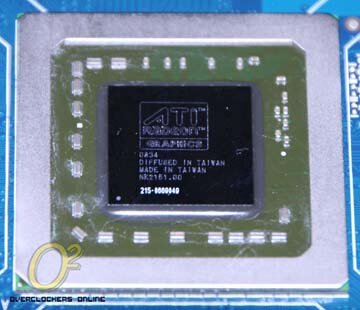
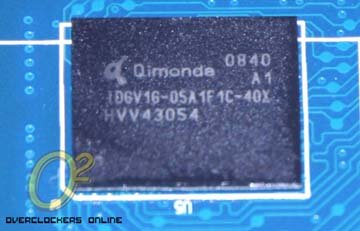
Page 6 : Installation & Overclocking
Installation is quite simple with the Toxic HD4870. The card measures 9-9/16′ long which shouldn't pose a big deal in most cases. The card requires an extra inch from the edge of the expansion slot to your side panel. This is necessary to accommodate the heatpipes for the cooler and shouldn't be an issue for most.
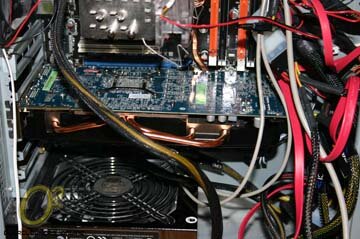
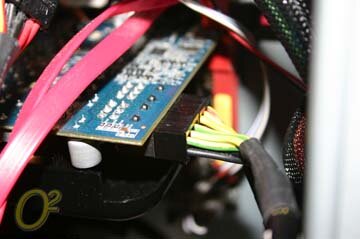
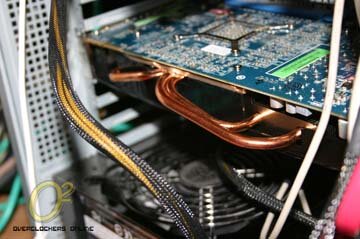
To overclock the card, I was limited to the ATI Catalyst Control Center as AMD GPU Clock Tool didn't support the latest drivers. Starting at 780/1000 I hit a stable plateau of 785/1045. This is a mere 5MHz gain on the core and 45Mhz on the memory. At 790MHz and 1050MHz, I was seeing some light artifacts at 785/1045. I ran both FurMark and ATItool for stability testing and kept watch of any artifacts. After four hours of ATiTool stress testing, I was pretty confident my card was stable. On the side, I also made sure I passed several runs of 3DMark Vantage, 3DMark 2006 and Crysis.
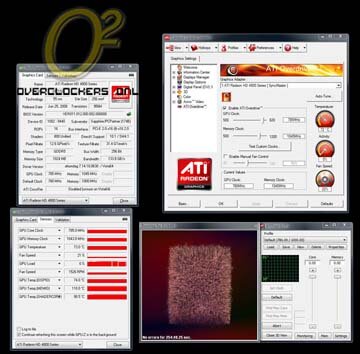
Page 7 : Temperature & Power Consumption
With the Vapor-X technology, I was expecting some good cooling numbers. At the same time, I know it's quite possible to manipulate the information we read and how things work. With my system, here are the temperatures I got under idle and load scenarios.
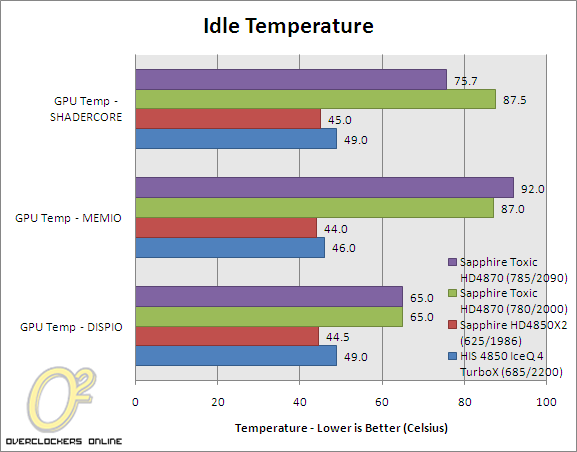
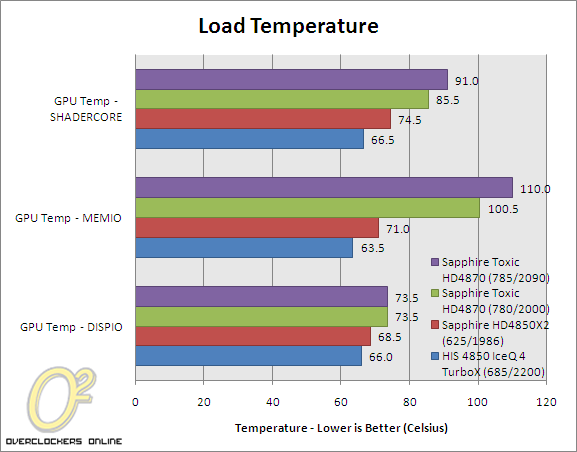
You can see that they are far from the 58.5C achieved by Sapphire in their labs. My idle room temperature was also at about 25C. While the temperatures may be warmer than the lab results, I'm still pleased by it because of how little noise the cooler made. Only on a few occasions would the fan blast up to a higher RPM making a loud whirl. Under most circumstances, including when gaming, it was pretty quiet; audible but not disturbingly loud.
Power consumption is a new addition to my review; I picked up a P3 Kill-A-Watt and started plugging it into everything I could. The power draw is not light by any means.
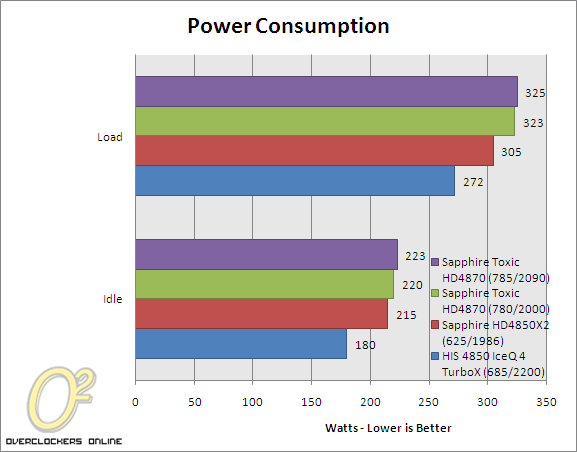
Let's start some benchmarking!
Page 8 : Test Configuration
Here is a complete list of the hardware that will be used for benchmarking and was used for stress testing.
- CPU: Intel C2D Q6600 (G0 SLACR L731B434) @ 2.71 GHz
- CPU Cooling: Thermalright HR-01 w/ 120mm Antec Tri-Cool Fan
- MB: Asus P5E3-Dlx Wifi-AP Edition
- RAM: Aeneon 2x2GB XTune DDR3-1600 @ 10-10-10-30 1T
- PWM/NB/SB Cooling: Stock
- PSU: Cooler Master Real Power Pro 850W
- HD: Seagate SATA 80 GB 8MB NCQ (ST380811AS)
- OS: Windows Vista x64
Video Cards:
- Sapphire Toxic HD 4870 1GB Catalyst 8.12
- Sapphire HD 4850 X2 Catalyst 8.12
- HIS HD4850 IceQ 4 TurboX Catalyst 8.8
- Sapphire Toxic HD 4850 Catalyst 8.8
- Diamond Multimedia HD 4850 Catalyst 8.8
- BFG NVIDIA GeForce 8800GT OC2 512MB GeForce 175.19
The benchmarks we'll take a look at include the following:
- Futuremark 3DMark Vantage
- Futuremark 3DMark 2006
- Futuremark 3DMark 2005
- Futuremark 3DMark 2003
- Cinebench Open GL Standard Test
- Lightsmark @ 1920×1200
Gaming Benchmarks
- Unreal Tournament III (DX 10) @ 1920×1200, 1920×1080, 1680×1050
- Crysis (DX 10) @ 1900×1200, 1920×1080, 1680×1050
- World in Conflict (Very High Detail) @ 1920×1200, 1920×1080, 1680×1050
8X Anti-Aliasing and 8X Anisotropic Filtering Gaming Benchmarks
- Unreal Tournament III (DX 10) @ 1920×1200, 1920×1080, 1680×1050
- Crysis (DX 10) @ 1920×1200, 1920×1080, 1680×1050
- World in Conflict (Very High Detail) @ 1920×1200, 1920×1080, 1680×1050
Page 9 : Futuremark, Cinebench & Lightsmark
The first four benchmarks I ran were from the Futuremark 3DMark family. We all know what Futuremark products are for, so I won't go over them. The Toxic 4870 1GB posted no surprisingly between the Toxic 4850 and 4850X2. The overclocked results were negligible in the sense that I only got a gain of 1%.
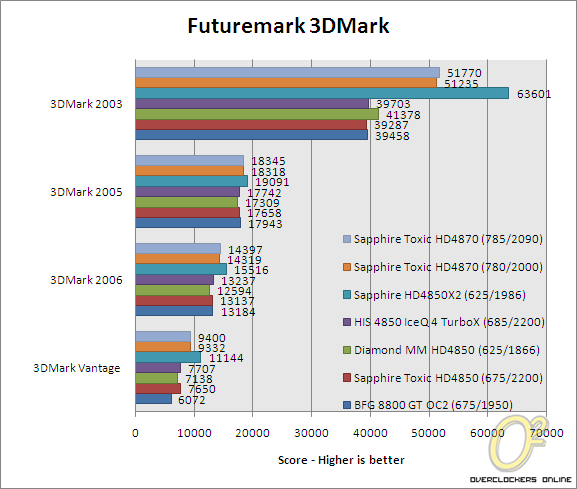
The second benchmark I looked at was Cinebench's OpenGL Standard Test. Cinebench is a real-world suite that assesses your computer's performance using Maxon's Cinema 4D software. Cinebench runs two tests but we're only interested in the second one:
The second test measures graphics card performance and is run inside the 3D editor window. The project file used can test all graphics cards that support the OpenGL standard. In this scene, only the camera was animated. This scene places medium to low demands on graphics cards and tests the maximum speed with which the scene can be properly displayed.
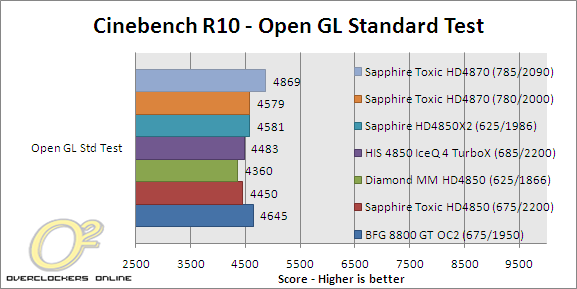
I was surprised to see the Toxic 4870 1GB come so close to the HD4850X2 and even surpass it with the overclocked frequencies.
The final benchmark for this chapter is with Lightsmark, a realtime global illumination and penumbra shadows enabled benchmark.
Natural lighting makes artificial graphics life-like. Computers get faster, but rendering more polygons doesn't add value if lighting looks faked, so insiders know that the next big thing is proper lighting aka Realtime Global Illumination. Typical workloads in realtime rendering will shift. Lightsmark simulates it. Global Illumination renders often take hours. Is your computer fast enough for realtime?
Lightsmark is another OpenGL based benchmark so we once again see the pattern of sub-par performance on the behalf of ATI. It doesn't appear as if Lightsmark has capitalized on the dual core as performance is proportional to the single core clock speed.
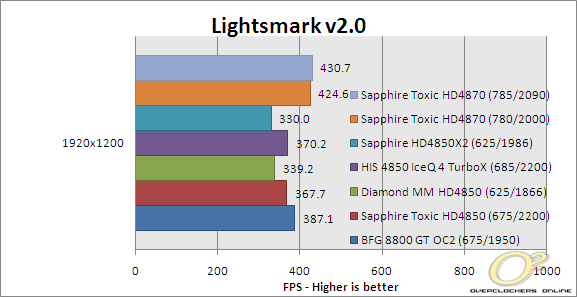
The Toxic 4870 kicked butt with Lightsmark, easily beating the competition by 50 frames.
While we're half done the benchmarks, the fun has really only begun as we fire up some games.
Page 10 : UTIII, Crysis & World in Conflict
Video games, the real reason why so many of us spend thousands of dollars on building the ‘perfect’ PC balancing power to price. There are countless games in the world that we could play and to benchmark them all would simple take a lifetime. I have decided to compare the results between three titles, some newer than others and some more demanding than others.
Starting with Unreal Tournament III, this game was released in 2007 and the Unreal Engine has been popular with many games but isn't the most demanding. Under DirectX 10 performance, we see some really high numbers, even with 8xAA and 8xAF enabled.
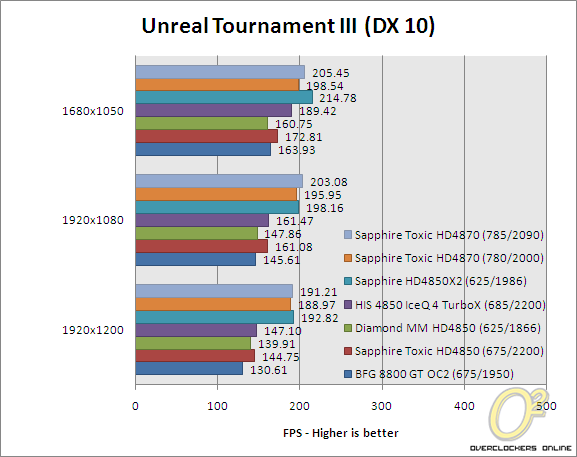
With both AA and AF enabled, the gap grows but there's no cause for concern. The numbers are fast enough that it's worth enabling AA and AF for the extra detail.
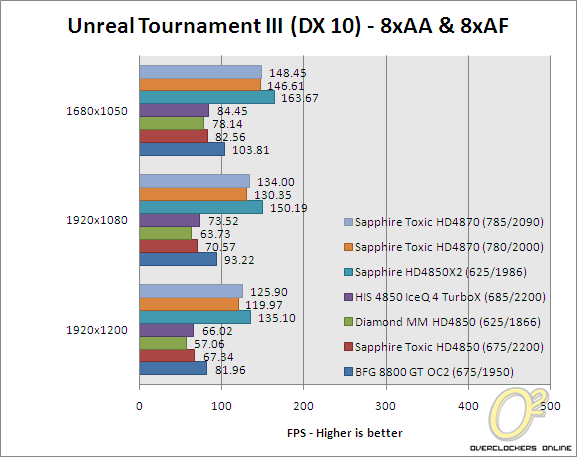
The Toxic 4870 1GB is able to stay within arm's reach of the 4850X2, at 1920×1200, we're only 1.5 frames per second away. That's hardly noticeable by the human eye. At the lower resolutions, the overclocked Toxic 4870 manages to overtake the 4850X2. I'm impressed.
Moving over to Crysis, this 2007 title uses CryEngine 2 and is the follow-up to the popular FarCry. The CryEngine 2 engine is extremely brutal, clearly making your video card the weakest link with playing Crysis or any game using the CryEngine 2 engine.
The Toxic 4870 1GB went toe-to-toe with the 4850X2 even beating it at 1680×1050 but losing by 3 frames at 1900×1200. As I mentioned earlier, you're not going to notice the 3 frames.
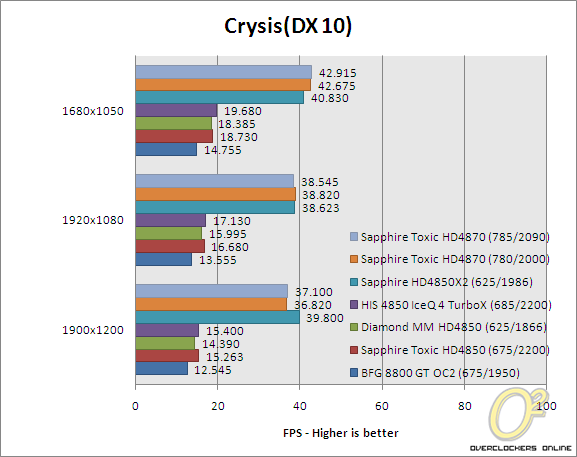
With anti-aliasing and anisotropic filtering enabled, the gap is significantly larger. The game plays at the high twenties to very low thirties frame rate – certainly far from ideal. The dual GPU HD4850 has a very clear advantage when it comes to performance after cranking up the detail.
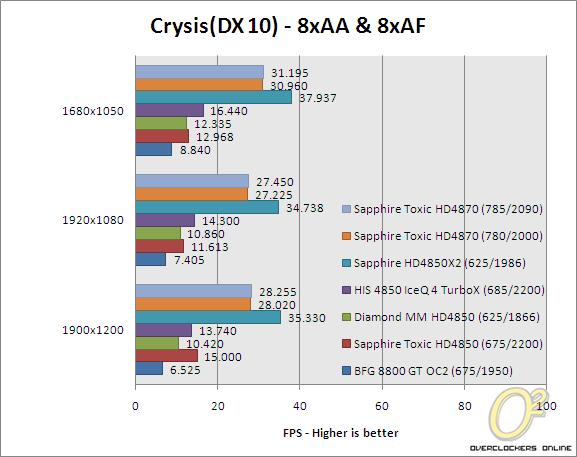
The final game I benchmarked with is World in Conflict at very high detail. World in Conflict came out last year and uses the Masstech Game Engine. It's a demanding engine but not to the extent of Crysis. From start to finish, the Toxic HD 4870 finishes in second. It easily destroys the single core 4850 and puts up a very good fight against the HD4850X2. The difference is four frames but with this game, that could make a difference from a good playing experience to a not so good one.
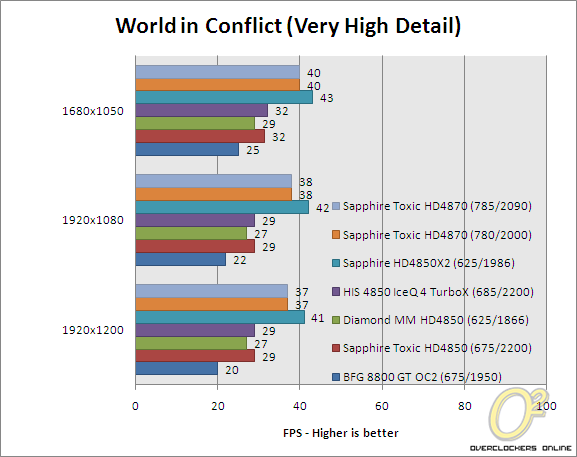
Turning on AA and AF resulted in a small performance drop. The Toxic 4870 still manages to be miles ahead of the 4850 and pretty close to the X2.
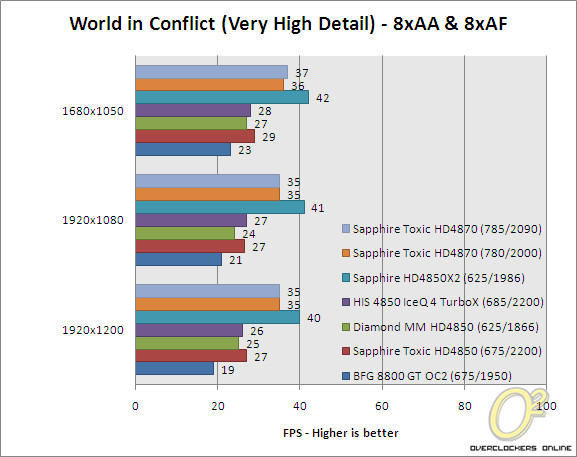
Overall, the card performed remarkably well against the competition. It went toe-to-toe against the HD4850X2 and easily beat out the single 4850. While the synthetic benchmarks showed a much larger gap between the three cards, it's quite clear the games paint a different story.
Page 11 : Conclusion
Sapphire continues to be innovative and brings new cards to the open market for consumers to pick. Expanding the Toxic family is the 4870 1GB DDR5 card, utilizing 3 heatpipes as part of the advanced Vapor-X cooler. The card from factory overclocked to 780/1000, 30 MHz faster for the core and 100 MHz faster on the memory. With recent price drop announcement on the 4870 family by ATi, this card becomes very attractive.
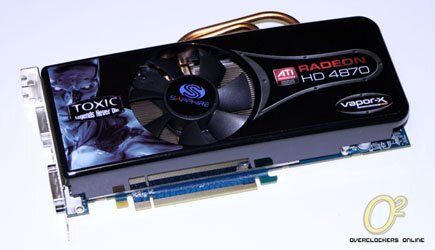
The card is priced well under the 4850X2 but the real world performance shows that it is just as good as one. The only place you'll notice a difference between the 4850X2 and 4870 is with synthetic benchmarking and on your VISA bill. It's pretty easy to recommend this card to friends and family.

Advantages
- Great performance
- Quiet cooling
- Factory overclocked
- Great price
Disadvantages
- Consumes a lot of power
- Couldn't further overclock the card
Overclockers Online would like to thank Sapphire Tech for making this review possible.